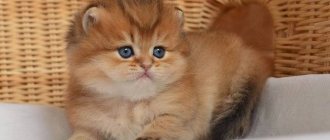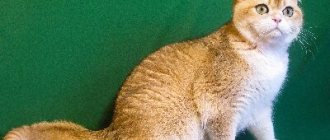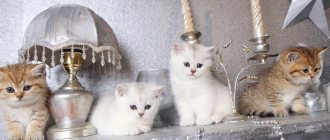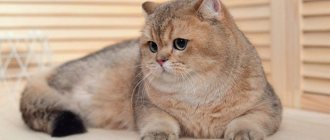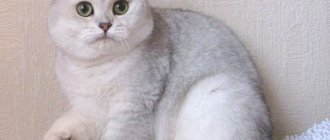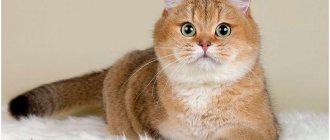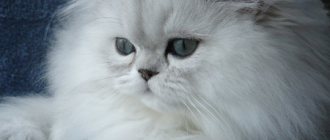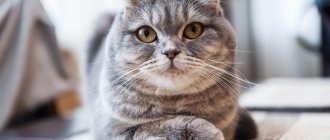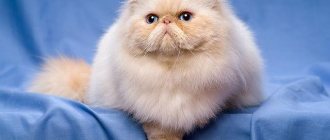Do you want to find a cute pet with a soft, affectionate character that will fill your home with love and warmth? The British chinchilla will become such a faithful friend.
Chinchillas are famous for their amazing fur color, which is bred from British, Persian and Scottish cats. The color of the fur is similar to that of the rodent of the same name. The coats of these cute cats are silver, gold or shaded.
Brief information:
- Name: British chinchilla;
- Year of breeding: 1880s;
- Country of breeding: Great Britain;
- Weight: from 4 to 8 kg;
- Height: height at withers 28-30 cm
- Life expectancy: about 15 years.
The history of the British chinchilla
The history of the origin of British golden chinchillas still causes a lot of controversy. There are several versions of the origin of these animals. According to the first of them, the ancestors of the chinchilla were brought to Britain from Ancient Rome. Followers of this theory are confident that the British are representatives of ancient cat breeds.
However, another part of the researchers is confident that golden chinchilla cats were bred by crossing with other breeds. Such selection work was carried out directly by English researchers. It is believed that the chinchilla owes its thick coat of beautiful color to the crossing of smoky British cats and Persian-colored cats.
This is interesting. Due to the fact that the British chinchilla was created by crossing short-haired and Persian cats, long-haired kittens can be found in the litter. However, the British Longhair cat must meet the same standards as the British Chinchilla.
Gradually, breeders continued crossing, diluting the new breed with the blood of Tabby cats. Experts managed to obtain a golden color using the method described above. But the basis for genetic experiments was no longer Tabby, but a new breed - the magnificent silver chinchilla.
The expectations of specialists were justified, and at the end of the 19th century an animal was obtained that met the golden chinchilla breed standard. These animals were officially recognized only at the end of the 20th century.
Care and maintenance of a silver chinchilla cat
Keeping a silver chinchilla is not much different from keeping other long-haired cats. A mandatory item in grooming is regular combing of the coat with a special brush.
If you do not comb your chinchilla properly, when licking the hairs, they enter the cat’s digestive tract, form a lump and can cause significant harm to the pet’s health.
The silver chinchilla tolerates swimming calmly; the water does not cause her to panic. In addition to the coat, it is necessary to monitor the teeth and the condition of the ears. To remove plaque on teeth, your cat's diet must contain solid food.
Like any cat, the silver chinchilla must undergo an annual vaccination procedure. Many are of the opinion that this is not necessary if the pet does not leave the apartment, but viruses dangerous to the cat can easily be brought in from the street along with dirty shoes.
Description of the Golden British Chinchilla
The basic characteristics of chinchilla cats correspond to the standards of the British Shorthair cat. The difference between these animals is the length and thickness of the fur; representatives of the first breed.
Appearance
British chinchillas are distinguished by a large, wide chest, strong hips and a straight back. In general, their physique is squat, their muscles are well developed. The weight of cats reaches 5-8 kg, cats 3-4 kg.
The breed standard requires compliance with the following appearance features:
- A rounded head with a wide forehead smoothly transitions into a rounded muzzle with round cheeks.
- The nose is straight, short, with a pinkish nose.
- Small ears, rounded at the ends, set wide apart.
- The neck is muscular and short.
- The round eyes are set shallowly. The ideal eye color for chinchillas is emerald, but yellow and blue shades are acceptable.
- The paws are proportional, muscular, but rather short, and therefore give the impression of being stocky.
- The tail is thick and not too long and ends with a rounded tip.
- The coat is short, thick, and the undercoat is well developed.
There are three main color options for chinchilla cats:
- Silver. Recognized as the most common color of the breed. The belly and chest of cats are almost always white, dark areas are localized on the back, sides and tail.
- Gold. The coat of such cats has a delicate peach tint. These pets are also called the British red chinchilla.
- Shaded silver. Compared to the usual silver color, the animal's fur looks darker. In this case, most of the length of the hairs is shaded, and the undercoat remains white.
This is interesting. Among British chinchillas there are color-point individuals. The colors on the ears, paws and tail of these animals are more “Siamese”, and the color of the eyes is blue.
Character
Golden Britons have a calm disposition. These pets are inactive and do not need constant games and physical activity.
Like all representatives of the cat family, the British have an independent disposition and, at the same time, are attached to their owner. Although chinchillas are affectionate, trusting cats and strive to spend as much time as possible near people, they need a separate place to rest.
Due to the lack of aggression on the part of chinchillas, they are often kept in families with children. These furry creatures almost never hiss and, moreover, do not extend their claws. If a golden cat feels irritated, she will simply move away from the place in which she feels discomfort. Golden chinchillas also get along well with other pets, including dogs or other cats.
For your information. Britons are one of the easiest breeds to train. From the first days of being in the house, this cat adopts the rules of the family in which it happens to live. The pet easily gets accustomed to the tray and scratching post.
Description of the breed (requirements for the standard)
British and Scottish cats have round, soft shapes and limbs that are proportional and harmonious. The compactness and roundness is achieved not only due to the thick coat, but also because representatives of the breed have very developed muscles. The front and hind legs are the same length, the tail has a slightly rounded tip.
The head is small but massive, with a well-defined chin. There is always a small plane on the forehead, however, if you look in profile, there will be a noticeable depression between the nose and forehead.
The ears of a chinchilla cat are wide and small, and the fur covers the back of them with a uniform, dense carpet. Huge eyes are set wide and very expressive, green in color (less often golden).
Contents of a gold Briton
Golden cats of the British breed are suitable for keeping both in a private house and in an apartment. Due to the peculiarities of the coat, shedding in representatives of this breed is almost unnoticeable, especially if it is combed in a timely manner.
Nutrition
Chinchillas can be fed prepared food or natural food.
Important! Under no circumstances should you mix natural food and prepared food. The same prohibition applies to several types of food.
When choosing a dry diet, it is better to focus on super premium or premium classes. Some manufacturers produce lines of food designed specifically for representatives of British breeds, taking into account their needs.
If the owner opted for a natural diet, it should include products such as:
- Raw meat (better lean: veal, turkey). Before serving, it should be placed in the freezer for 12 hours, then doused with boiling water to disinfect it.
- Offal (liver, lungs) boiled or steamed.
- Boiled fish (without bones).
- Low-fat fermented milk products.
- Eggs (preferably quail), 2 times a week.
- Cereals (rice, buckwheat, etc.).
- Vegetables.
The following should be excluded from your pet's diet:
- smoked meats, sausages;
- canned food;
- salty, spicy foods;
- raw milk.
Chinchillas' diet must be balanced. If the animal prefers natural food, vitamin complexes should be added to it from time to time. Drinking water should always be located near the food bowl . It should be changed daily.
How many times a day should you feed your cat?
Chinchillas are prone to overeating and subsequent obesity.
These animals do not know moderation in food, and therefore the dose of delicacy offered to them should be accurately measured. If we are talking about dry food, its quantity must correspond to the data in the table on the package. The amount of natural food is calculated based on the weight and activity of the pet. Leftovers left uneaten by the animal are immediately removed from the bowl. Small kittens eat 6 times a day. Gradually, the number of feedings is reduced, and the animals switch to the feeding regime of an adult cat. The latter are fed 2-3 times a day in small portions.
Walks
The number and duration of promenades depends on the cat's temperament. Some golden pets are content to stay indoors; they are not at all drawn to the street. And other four-legged animals are not at all averse to getting to know the world outside the home.
A chinchilla should be walked on a leash. Before going for a walk, you should take care to protect your animal from parasites. Collars, drops and other means are suitable for this purpose.
Toilet
The golden British chinchilla visits a tray of any size and capacity. Since animals are quite impressive in size, it is better to choose a stable and large toilet for them. Any filler can be used.
Advice. When training a kitten to use the toilet, at first you should purchase the litter that the baby is accustomed to in the nursery. A conscientious breeder, when transferring the baby to a new owner, will provide the latter with all the necessary information.
Care and maintenance
The Scottish Fold chinchilla has quite long hair, so it needs to be brushed from time to time. This is especially worth doing during molting. Otherwise, by licking itself, the cat may clog the digestive tract. In addition, an animal with unkempt fur will lose all its charm.
It is also necessary to trim the nails and regularly wash the ears and eyes. The latter often begin to water in lop ears - in this case, they can be washed with a very weak solution of potassium permanganate, after carefully examining it in the light so that there are no undissolved crystals left in it.
Felinologists have different opinions about bathing the animal. Some experts argue that it is possible and necessary to bathe Scottish fold chinchillas, especially since the animal itself usually tolerates this procedure calmly. Others are of the opinion that if the cat is not walked and is constantly in the house, with regular brushing it is not at all necessary to give the pet bath days.
Appearance care
Complete care for the appearance of a British chinchilla consists of several activities that should be carried out strictly.
Combing
The coat of golden chinchillas includes guard hair and undercoat. Such a multi-level cover needs careful care. Combing is carried out first in the direction of hair growth, and then against the grain. This procedure is performed twice a week, using a special glove or a fine-toothed comb.
Bathing
Despite the fact that the coat of golden chinchillas is quite light, it does not get dirty very often. Therefore, there is no need to bathe your pet often - once every 3 months is enough.
For washing, special shampoos and softening conditioners are used. If there is an urgent need, you can use dry products for washing cat fur, which are selected taking into account the color of the pet.
Ear care
Chinchillas' hearing organs should be carefully examined every 2 weeks. Ear care involves removing dirt and dark plaque using cotton wool. The latter should be moistened with a special composition intended for caring for the ears of cats.
Eye care
The visual organs of British chinchillas require careful care, as they tend to bleed profusely. This process is explained by the original structure of the animal’s tear ducts.
Pets' eyes should be examined regularly to prevent clots from accumulating in the corners. Every morning, the animal’s eyes are wiped with a cotton pad soaked in a solution of boric acid, warm boiled water or a decoction of herbs.
If suppuration is observed, it is permissible to use tetracycline ointment. Progressive eye pathologies require immediate attention to a veterinarian.
Nail care
The claws of golden cats are trimmed once every 2-3 weeks, using special scissors called nail clippers. The pet can remove keratinized particles themselves using a scratching post installed in the room. The latter must be stable and securely fastened.
Dental care
To prevent possible problems with the Briton’s gums and teeth, his oral cavity should be treated once a week. A soft, flexible brush and toothpaste that does not require rinsing are suitable for this purpose.
Character
These animals love to communicate, so you shouldn’t leave them alone for a long time, but they will calmly endure a day without their owner, who has gone to work. At home, your pet will follow you everywhere; he loves to watch TV together.
They have two shades of voice, but they give it many intonations, from which an experienced owner can draw conclusions about the cat’s internal state. But more often they are silent. It is better to talk to him in a gentle, confidential tone, then he will feel comfortable.
Four-legged animals communicate with children in a special way. They don’t offend them, but they don’t indulge everyone who comes. They are happy to play and communicate with human cubs, but if you offend them, they will simply leave, but they will not scratch them.
However, most of the time they are friendly and nice. But they are unlikely to get along with other representatives of their species. They are dominant and will prove their superiority.
Animals love affection, but do not tolerate restrictions on their freedom, so you should not squeeze them or take them by force. They are very smart and quick-witted, aware of their importance and dignity and behave with innate aristocracy.
They are very loyal and peaceful. Usually unobtrusive, calm and somewhat imposing, very active only in youth.
They are characterized by independence and stubbornness, they need personal space, so be sure to purchase a special house. They are easy to train, photogenic, and endlessly intelligent.
Purchasing a British Golden Chinchilla kitten
Purchasing purebred British chinchilla kittens is not easy. It is better to choose purebred representatives in trusted nurseries or by contacting reliable breeders who breed this particular breed.
Attention! When purchasing an animal on the market or through a private advertisement, there is a high risk of being deceived and becoming the owner of an ordinary kitten with an unusual color.
Criterias of choice
When choosing a British chinchilla kitten, you should consider a number of recommendations:
- Carefully study the breed standard.
- Make a list of breeders and nurseries. Study reviews about them, become familiar with the peculiarities of keeping animals.
- Be sure to look at the kittens' parents, taking into account their compliance with the breed standard. The breeder will certainly provide a pedigree confirming the purebred of the sires up to the 4th generation.
The immediate choice of a kitten should be approached by paying attention to some features:
- Behavior. When a kitten sees a stranger, it should not try to hide in a corner in horror. A healthy baby is cheerful and inquisitive.
- Appearance. The kittens' coat should be shiny, their eyes and ears should be clean, and their nose should be moist.
- Relevant documents: metrics, pedigree, veterinary book, etc.
At what age is it better to adopt a kitten?
Conscientious breeders hand over kittens to new owners no earlier than 3 months . Babies of this age can already feed themselves and are also trained to use a tray.
Breed defects
British chinchillas are not very sick animals, their health is strong. However, genetic diseases that appear as a result of inbreeding are typical for the breed.
Tendency to diseases
British Chinchilla cats may be susceptible to certain diseases, including:
- Retinal atrophy. It is considered a hereditary pathology and can cause decreased vision or loss of vision.
- Polycystic kidney disease. A hereditary disease accompanied by the formation of fluid cysts. At the same time, the quality of blood purification deteriorates, which can provoke intoxication, sepsis and death.
- Hypertrophied cardiomyopathy. Hereditary pathology of the cardiovascular system. Can lead to blockage of blood vessels, pulmonary edema and death of the animal.
You can avoid purchasing a pet with genetic abnormalities by contacting a trusted breeder. At the first alarming symptoms, the cat should be immediately shown to a veterinarian.
Defects in appearance
The following are recognized as serious defects in the appearance of chinchillas:
- thin, sunken cheeks;
- obvious depression on the nose;
- sparse or excessively soft wool;
- high-set ears;
- excessively elongated muzzle;
- flat forehead.
Some shortcomings exclude the British from participating in the competition. These include:
- skeletal deformities;
- deafness;
- blindness;
- anomalies of the eyelids, teeth, jaws.
For your information. Chinchilla coloring has a number of nuances, and certain requirements are imposed on it. Only a specialist can understand the intricacies of animal coloring.
Health
In general, chinchilla cats can boast of good health. However, some hereditary diseases have not escaped them.
See also: Balinese cat: long-legged beauty with sapphire eyes
Polycystic kidney disease. Unfortunately, the disease is almost invisible in the early stages. In the later period of the disease, the animal’s abdomen increases in size and pain occurs.
Hypertrophied cardiomyopathy. Ultrasound will help identify the disease. The first symptoms are fatigue and shortness of breath.
Retinal atrophy. The eyes of a chinchilla are a kind of “Achilles heel” of the animal. Increased tear production and lack of regular care together can lead to complete blindness of the pet. Extremely dilated pupils and an unnatural shine in the eyes indicate that it is time to consult a veterinarian.
With proper care, the average life expectancy of chinchilla cats is twelve to fifteen years.
Breeding the British Chinchilla breed
Breeding British chinchillas is quite a complex matter. For this reason, it is recommended that only experienced breeders engage in it.
Criteria for choosing a partner
Finding a suitable pair for a chinchilla is quite problematic due to the small number of the breed. The offspring are characterized by deviations in color, and therefore crossing is carried out by a limited number of individuals and only among the chinchilla variety.
A potential mating partner must meet certain criteria:
- absence of gene pathologies;
- availability of the necessary documents: veterinary passport, pedigree, breeding permit, etc.;
- deworming, vaccination (must be carried out 2-3 weeks before mating).
The chosen "groom" or "bride" must correspond to the characteristics of the breed, especially with regard to coloration.
At what age should you give your pet for the first mating?
British chinchillas reach sexual maturity late. In view of this, mating should begin when the pet is 20-24 months old. Excessively early birth will not have the best effect on the cat’s immature body. In addition, the offspring in this case often turns out to be weak or non-viable.
